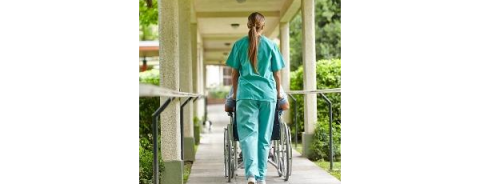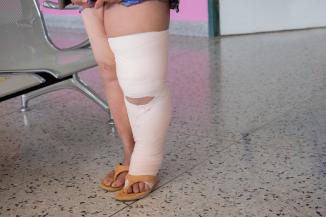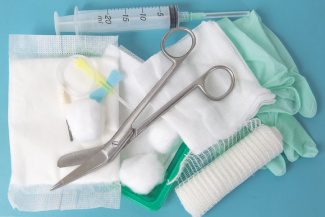Bridging the Gap: Maintaining Continuity in Pressure Ulcer Risk Assessment
November 25, 2015
It has become quite easy to look at pressure ulcer prevention in most health care settings. From acute care, through the ED and on to the OR and ITU, then to the various floors of med surg, orthopedic, not forgetting rehab and community nursing. Pediatric and neonatal units have better defined pressure ulcer risk assessment tools to utilize that have made assessment and planning care much less haphazard for those patients than in the past. The prevention and treatment of pressure ulcers does not lay with any one of the above areas but all of them, all the time for every patient at risk.
Limitations in Pressure Ulcer Risk Assessment
Most of these acute care units are in a position to do skin checks and use a variety of assessment tools so they identify the patients at risk from pressure ulcers and can then plan care appropriately. Of course, these risk assessment tools do not cover everything, which is why refinements are necessary for pediatrics and long-term care. Even then, some risk assessments do not look at age, deformities, casts, splints, other devices, underlying diseases, drugs and specific therapy needs (such as exercise bikes, sliding the heel when exercising the knee, etc.), so nurses need to know and understand the limitations of the assessment tools they use. There are departments that have no pressure ulcer risk assessment tool to use and because the patients come and go within fairly short time frames (2-4 hours), it is probably not reasonable for them to perform detailed skin checks and pressure ulcer risk assessments.
Patients would undoubtedly wonder at the need as most would not be at risk at all. Patients arrive fully dressed though it may be necessary for them to put on a hospital gown, to do so specifically for a skin check would be a little odd (not to say time-consuming and mostly unnecessary). Our segmented health care system necessitates patients being transferred from one place to another for tests and treatments. The patient's risk remains, but their care becomes fragmented. A transfer from a skilled nursing facility to an oncology department, X-ray or dialysis puts the patient's skin at risk. Dialysis and oncology units often utilize recliners and the nurses in these units may not be able to reposition patients. Dialysis is contracted out by some facilities, so rather than their patients going to a dialysis unit, the dialysis nurse comes in to them. Some of these contracted staff may think it is not their responsibility to reposition the patient during their visit and the patient's nurse or assistant may not appreciate or feel comfortable doing so.
Pressure Ulcer Prevention Across Health Care Settings
While working in a critical access unit, I would consult for the oncology clients on occasions. I suggested they think about how to educate the patients regarding pressure ulcer prevention and advised they get some simple cushions. Mostly they found out about pressure ulcers when patients complained of discomfort or because the patient brought in a cushion (usually a donut) with them. It is possible for a wheelchair bound patient to have two hour rides sitting in his/her wheelchair, transfer with minimal assistance into a recliner, sit for 5 hours and never have his or her skin examined or even be asked about his skin integrity. While able to provide some pressure relief in a wheelchair by performing pushups, this is not often possible in a recliner. This traditional form of pressure relief may not be sufficient for clients at high risk or who actually have a pressure ulcer.1, 2
Additionally some units do not consider it their prerogative to provide any type of pressure reduction surface. What can we do? How can we approach pressure ulcer prevention in environments where few patients are at risk or the nature of nursing interaction does not lend itself to the detailed or intimate care necessary to provide a thorough skin assessment? The first issue is assessment of pressure ulcer risk, the second is skin assessment, the third is education and lastly, preventative strategies. Using a current pressure ulcer risk assessment tool and inspecting the patient's skin might not be appropriate in all health care settings, but providing an educational leaflet that gives website references and letting the patient know you will be asking a few questions regarding their skin at their visits is one approach that may work well. Assuming that only patients that are thin or unable to move well are at risk is not sufficient. Providing a leaflet about pressure ulcers (preferably one specific to the population served) then going over it briefly while asking the client if they have any 'sore spots' is not time consuming and will be educational.
Positioning Techniques For Pressure Ulcer Prevention
Pressure ulcer prevention can be focused on those moments when the client transfers or goes to the bathroom. For those who are in a wheelchair or bound to a stretcher, building in two repositionings as part of 'comfort rounding' may be the way to go. It is likely that drastic repositioning will not be easy, or even possible, particularly if two people will be required. Generally the problem is the sacrum/coccyx area and the heels. The heels are relatively easy. If elevated, offloading will be assured so all that should be needed is a gentle pillow puff up and leg realign. The biggest issue with the heels is educational as most people when asked to put their feet up will rest the weight of their legs on their heels. Teaching people to float their heels is very important.
For the buttock area a small tilt can be achieved with minimal effort. One leg of the patient is raised up onto two pillows, the bottom leg abducted a little and the buttock scooped though. A third pillow is positioned above the small of the back. This 'quantum tilt' relieves the coccyx and part of the sacrum, so knowing which side a pressure ulcer is located becomes important. The quantum tilt can be done by one person except if the client is large and totally unable to assist. The quantum tilt can be used in a recliner or on a stretcher. If no pillows are available it can be performed for a short 5 minute 'off the butt break' by the client bending their knee and the caregiver assisting the roll onto the opposite hip area. It is easy to perform this tilt on an ambulance stretcher and the safety straps for transport can still be secured. It is safe to use with people who have had hip replacement surgery and is surprisingly effective at giving complete coccyx offloading when done well. It is not always easy to do well as it works best if the legs are relaxed and parted a little.
As it is such a small tilt, trying it at home on a hard surface usually convinces staff of its merit. Performing a regular 30 degree tilt3 requires two people and will not be comfortable for most patients in a recliner. Forward leans are not possible in a recliner but can provide relaxing coccyx relief for seated patients in some settings, though safety needs to be addressed. Providing a suitable surface (with no wheels) of the correct height to lean on may be easier in some settings than others. Justification for changing pressure ulcer risk assessment and prevention strategies, particularly in wheelchair bound clients, has emerged over the last few years4 and needs to be acted on in all settings including departments such as oncology units, dialysis, radiology and out patients.
References
1. Gefen A. The biomechanics of sitting-acquired pressure ulcers in patients with spinal cord injury or lesions. Int Wound J. 2007 Sep;4(3):222-31. doi:10.1111/j.1742-481X.2007.00330.x.
2. Stinson MS, Schofield R, Gillan C, et al. Spinal cord injury and pressure ulcer prevention: using functional activity in pressure relief. Nurs Res Pract. 2013;2013:860396. doi:http://dx.doi.org/10.1155/2013/860396
3. Shea JD. (1975). Pressure sores: classification and management. Clinical Orthop Relat Res. 1975 Oct;112:89-100.
4. Lavrencic L. A review of the literature to determine the recommended nursing interventions aimed at decreasing the risk of pressure ulcer development in patients with spinal cord injury. Wound Practice and Research. 2011 Mar;19(1);6, 8, 10-13.
About The Author
Margaret Heale has a clinical consulting service, Heale Wound Care in Southeastern Vermont and draws on her extensive experience as a wound, ostomy and continence nurse in acute and long-term care settings to provide education and holistic care in her practice.
The views and opinions expressed in this blog are solely those of the author, and do not represent the views of WoundSource, HMP Global, its affiliates, or subsidiary companies.












Follow WoundSource
Tweets by WoundSource